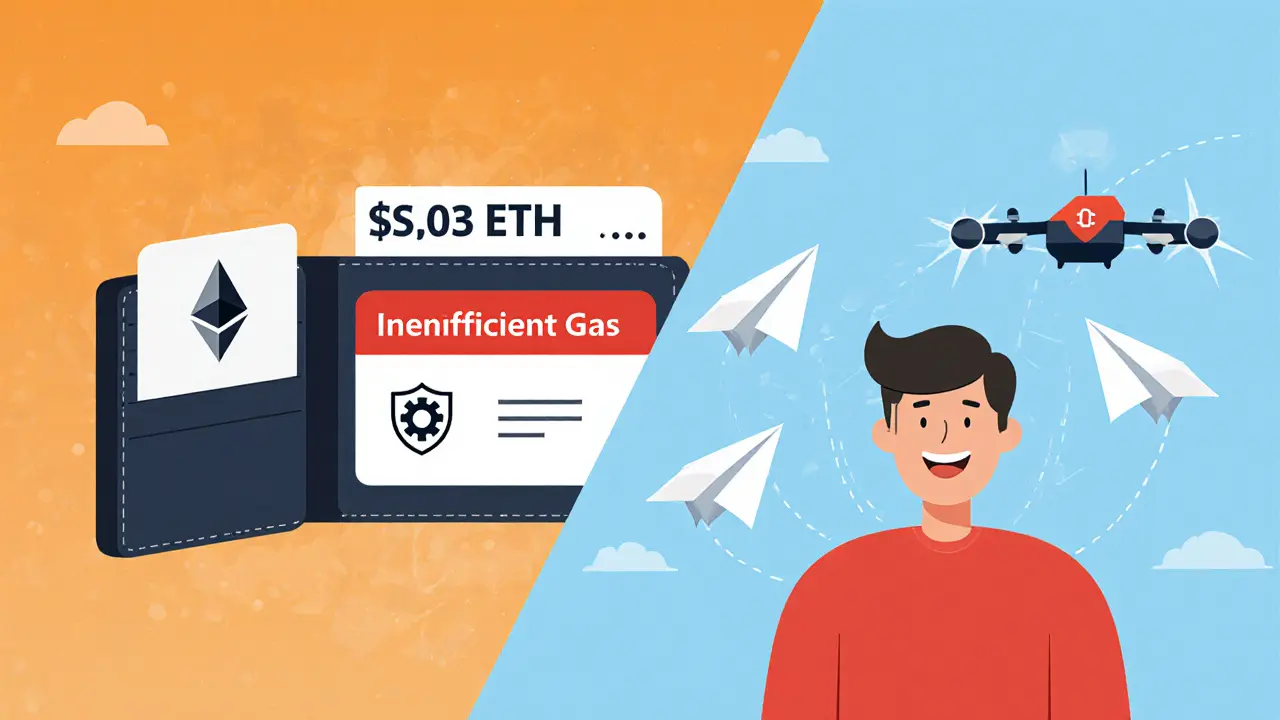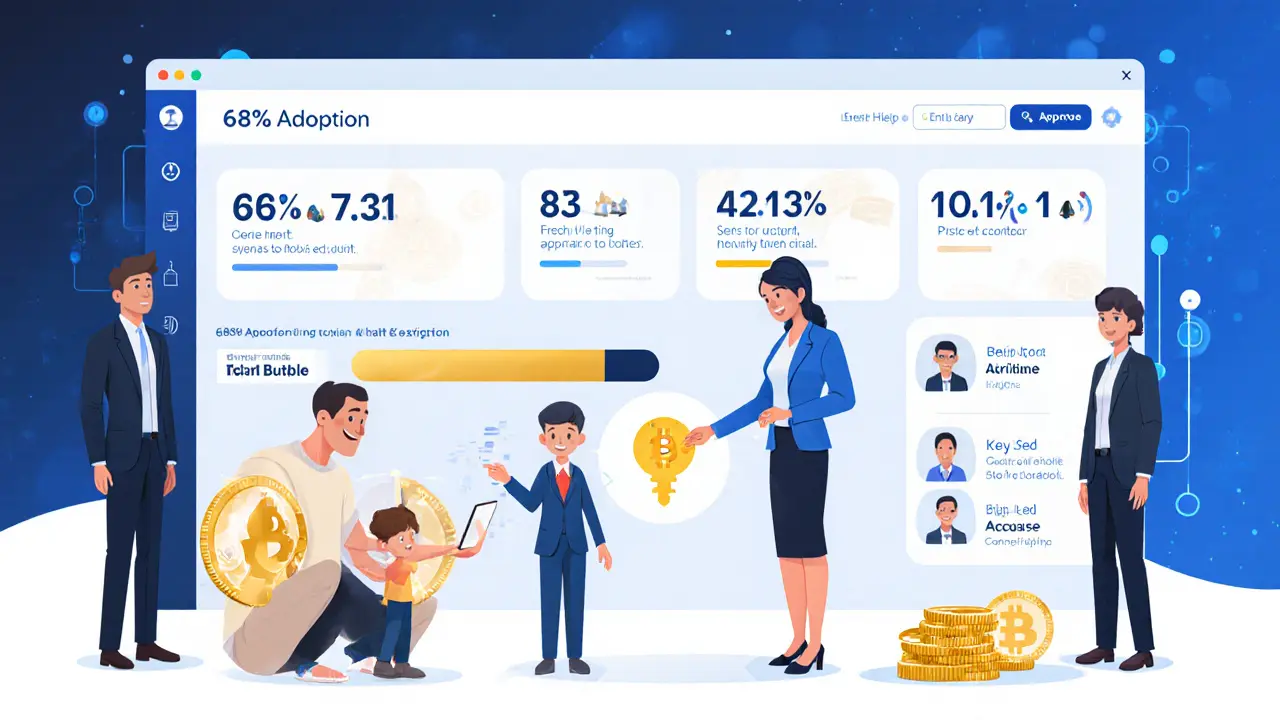
ERC-4337 Gasless Transaction Cost Calculator
See how much USDC you'd need to cover gas fees using account abstraction. The calculator shows the equivalent value of gas costs in USDC based on current Ethereum network prices.
How Gasless Transactions Work
When using account abstraction, a Paymaster contract can pay gas fees on your behalf. Instead of holding ETH, you pay with tokens like USDC. The Paymaster handles the conversion to ETH for blockchain transactions.
Key Insight: With account abstraction, you never need to hold ETH to pay for gas. The Paymaster converts your USDC (or other tokens) to ETH before submitting the transaction.
Total gas cost:
0.00063 ETH
Equivalent USDC cost:
$1.57 USDC
How this works: Your transaction is processed by a Paymaster contract. The Paymaster converts the equivalent USDC value to ETH and pays the gas fee on your behalf. You pay in USDC instead of ETH.
Imagine sending your first crypto transaction without needing to buy ETH just to pay a fee. No more panic when your wallet shows $0.03 left and you need $5 to send $20 worth of USDC. That’s the reality account abstraction makes possible - and it’s already changing how millions experience Web3.
What Exactly Is Account Abstraction?
Account abstraction isn’t just a buzzword. It’s a fundamental shift in how wallets work on Ethereum and compatible chains. Before this, every user had to rely on an Externally Owned Account (EOA) - a simple key pair that could only send transactions but couldn’t run code. If you wanted to do something smart - like require two signatures to spend or recover your wallet with a friend’s help - you were stuck. You needed a separate smart contract, and even then, you still had to use an EOA to trigger it. Account abstraction breaks that rule. It lets smart contracts act like your wallet. Now your account isn’t just a key - it’s a program. You can set rules: "Only allow transfers after 24 hours," "Require approval from my spouse," or "Pay gas in USDC instead of ETH." This is made possible by ERC-4337, a standard introduced in 2021 and widely adopted by 2023. It doesn’t require changing Ethereum’s core protocol. Instead, it layers on a new system that works alongside it.How Gasless Transactions Actually Work
The magic behind gasless transactions comes down to three parts: UserOperations, Bundlers, and Paymasters. When you click "Send" in a gasless app, your wallet doesn’t broadcast a normal transaction. Instead, it creates a UserOperation - a special data package that includes what you want to do, your signature, and which token you want to pay with. This doesn’t go into the regular Ethereum mempool. It goes into a separate one, watched by Bundlers. These are special nodes that collect dozens of these UserOperations, bundle them together, and submit them as one transaction to the blockchain through a central Entry Point contract. Here’s where it gets interesting: the Paymaster. This is a smart contract that can pay the gas fee on your behalf. It might be funded by the dApp itself - like a game that wants you to try its NFT mint without asking for ETH. Or it could be a third-party service that accepts your USDC, converts it to ETH, and covers the cost. You never touch ETH. The Paymaster handles it all. This system reduces failed transactions by up to 78%, according to Utila.io’s 2023 tests. New users aren’t getting locked out because they didn’t buy ETH first. They’re just sending tokens - and the system takes care of the rest.Why This Matters More Than You Think
The biggest problem in Web3 isn’t blockchain speed or scalability. It’s friction. Cpay.world found that 63% of first-time users abandon a transaction because they don’t have enough ETH for gas. That’s not a technical issue - it’s a UX disaster. Account abstraction fixes that. It turns a confusing, intimidating step into a silent background process. But it’s not just about convenience. Smart accounts offer real security upgrades. You can set up social recovery - if you lose your phone, you can recover your wallet using trusted contacts instead of a 12-word seed phrase. You can add time delays on large withdrawals. You can require multi-signature approval for corporate funds. These features were nearly impossible with EOAs. Now, they’re built into the account itself. Enterprise adoption is already accelerating. Utila.io’s 2023 report showed 68% of institutional crypto managers now use account abstraction for treasury workflows. Why? Because batch transactions cut processing time from 45 minutes to under 7 minutes. Automated compliance checks can block transfers to sanctioned addresses. Hierarchical access controls let CFOs approve spending without touching private keys.
The Hidden Costs and Risks
Gasless doesn’t mean free. Someone - a dApp, a Paymaster, or a sponsor - is paying for it. That creates new risks. Paymaster contracts are smart contracts. And smart contracts can be hacked. Nonbank.io’s 2023 security analysis warned that a compromised Paymaster could drain all users’ funds. If the Paymaster is centralized - say, one company controls all the funding - then you’re trusting them not to censor your transactions or disappear with the money. That’s a new kind of centralization. Also, not all dApps support it. A user on Twitter in July 2023 complained: "I sent USDC to a friend but the transaction failed because I didn’t have ETH - why doesn’t EVERY app work like the one that let me pay gas in USDC?" That inconsistency is a real problem. Users expect seamless experiences. When only some apps work, it creates confusion and distrust. And there’s latency. Because your transaction has to go through a UserOperation, get bundled, and be verified by the Entry Point, it can take 2-4 seconds longer than a normal EOA transaction. For high-frequency trading, that’s a problem. For sending a gift NFT? Barely noticeable.What’s Being Done to Fix It
The community is already responding. Thirdweb rolled out social recovery in August 2023, letting users pick trusted contacts for wallet recovery. Sequence.xyz expanded gas payment options from 2 to 4 tokens in September - now supporting ETH, WETH, USDC, and DAI. Developers are building better tools. Thirdweb’s SDK lets engineers integrate account abstraction in 3-5 days, and their documentation scores 4.7/5 from developers. The Ethereum Foundation is also working on native solutions. EIP-3074 and future upgrades aim to bake account abstraction directly into the protocol, removing the need for the current ERC-4337 workaround. That could make it faster, cheaper, and more secure. Meanwhile, researchers are combining account abstraction with zero-knowledge proofs. Imagine logging into your wallet using your Google or Apple account - no seed phrase needed. That’s zkLogin, and early tests show it could solve both recovery and security in one go.
Should You Use It?
If you’re a regular user: yes - if the app supports it. Look for wallets like Argent, Safe, or Sequencer that already offer gasless onboarding. You’ll notice the difference the moment you send your first token without buying ETH first. If you’re a developer: start experimenting. The learning curve isn’t steep. A 2023 survey found experienced Solidity devs needed just 17.5 hours to get comfortable with ERC-4337. Use Thirdweb’s SDK or Sequence.xyz’s tools. Test Paymaster security. Audit every contract. Don’t assume the provider has done it for you. If you’re building a business: this isn’t optional anymore. Enterprise adoption is 3.2 times higher than consumer use. If your users are struggling with gas, you’re losing them. Account abstraction isn’t just a feature - it’s the new baseline for Web3 onboarding.What’s Next?
By the end of 2024, Messari predicts 80% of new Web3 apps will have gasless transactions built in. Consensys forecasts 60% of new users will have it as their default experience within 18 months. That’s not speculation - it’s what’s already happening. The future of Web3 isn’t about faster block times or cheaper fees. It’s about removing the mental load. People don’t want to learn how to manage gas. They want to send money, buy NFTs, join communities - and not be blocked by a technical hurdle they didn’t ask for. Account abstraction doesn’t just fix gas. It fixes the first impression of Web3. And that’s why it’s not just a technical upgrade - it’s the key to mass adoption.Are gasless transactions really free?
No, they’re not free. Someone - usually the dApp, a sponsor, or a Paymaster contract - pays the gas fee on your behalf. You might pay in USDC or another token, and the Paymaster converts it to ETH for the blockchain. But you never need to hold ETH yourself. The cost is just hidden, not eliminated.
Can I use account abstraction with MetaMask?
Not natively yet. As of 2025, MetaMask does not support ERC-4337 out of the box. However, they’ve publicly announced plans to integrate it. In the meantime, you can use wallets like Argent, Safe, or Sequencer that already support smart accounts and gasless transactions.
What tokens can I use to pay for gas with account abstraction?
It depends on the Paymaster. Common options include ETH, WETH, USDC, DAI, and MATIC. Some dApps let you pay in any ERC-20 token they support. The Paymaster handles converting your chosen token into the network’s native currency (like ETH) before submitting the transaction.
Is account abstraction more secure than regular wallets?
It can be - if implemented correctly. Smart accounts let you add multi-sig, time delays, social recovery, and access controls that EOAs can’t. But they also introduce new risks: if the Paymaster or account contract is hacked, your funds could be stolen. Security depends on the code, not just the concept. Always check if the wallet or dApp has been audited.
Why don’t all apps support gasless transactions?
Because it requires extra development work. Developers need to integrate Paymasters, configure bundlers, and test the flow. Many smaller dApps still rely on traditional EOAs because it’s simpler. Adoption is growing fast, but it’s not universal yet. Look for the "Pay with USDC" or "No ETH needed" labels - they’re your clue that account abstraction is active.
Can I recover my wallet if I lose my phone with account abstraction?
Yes - and that’s one of its biggest advantages. Many smart wallets now offer social recovery. You can designate 2-5 trusted contacts (like family or friends) who can help you regain access without a seed phrase. Some even let you recover using biometrics or login via Google or Apple. This removes the biggest fear of losing crypto: forgetting or losing your 12-word phrase.
Leave a comments